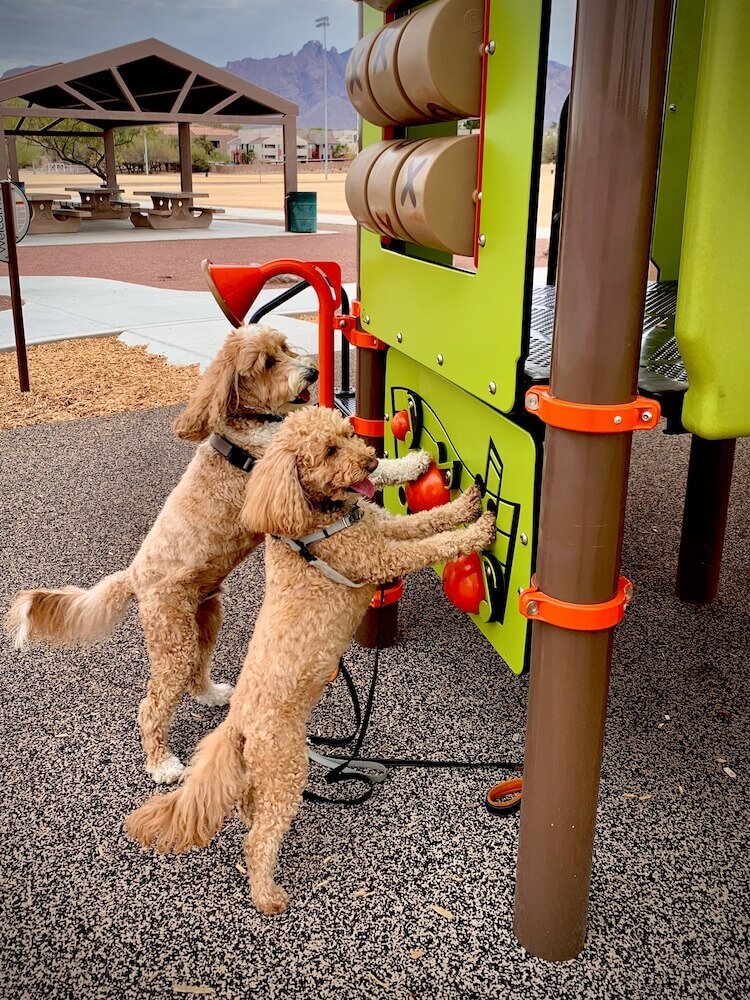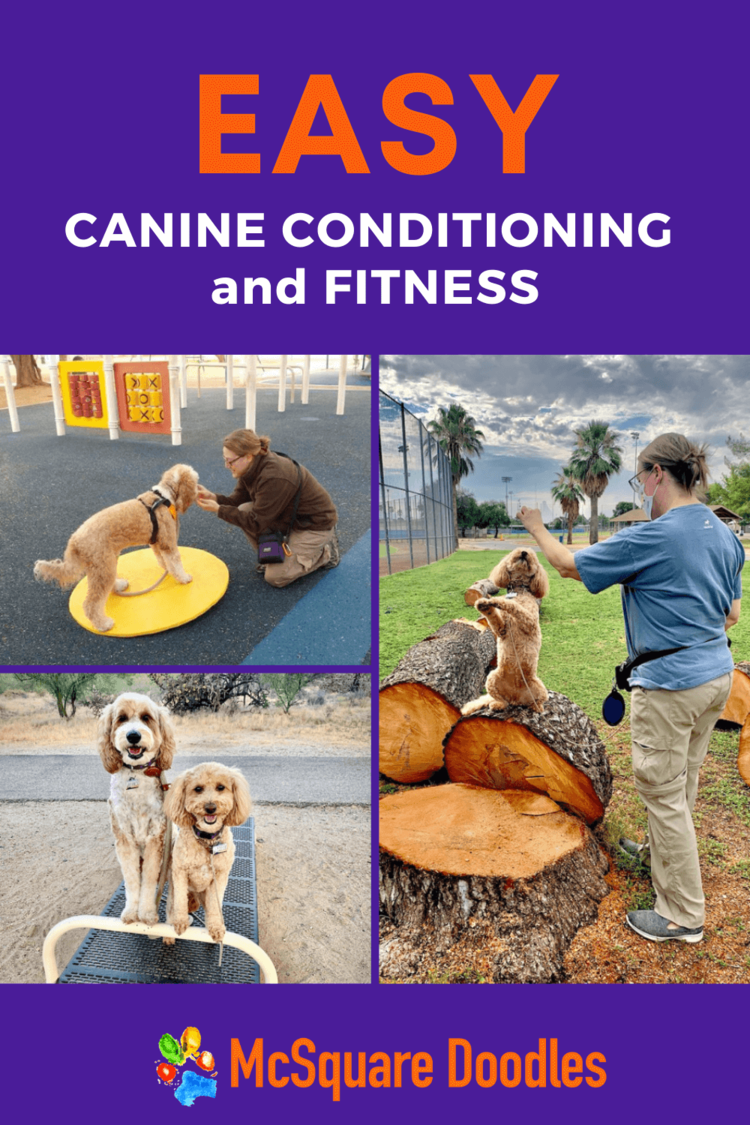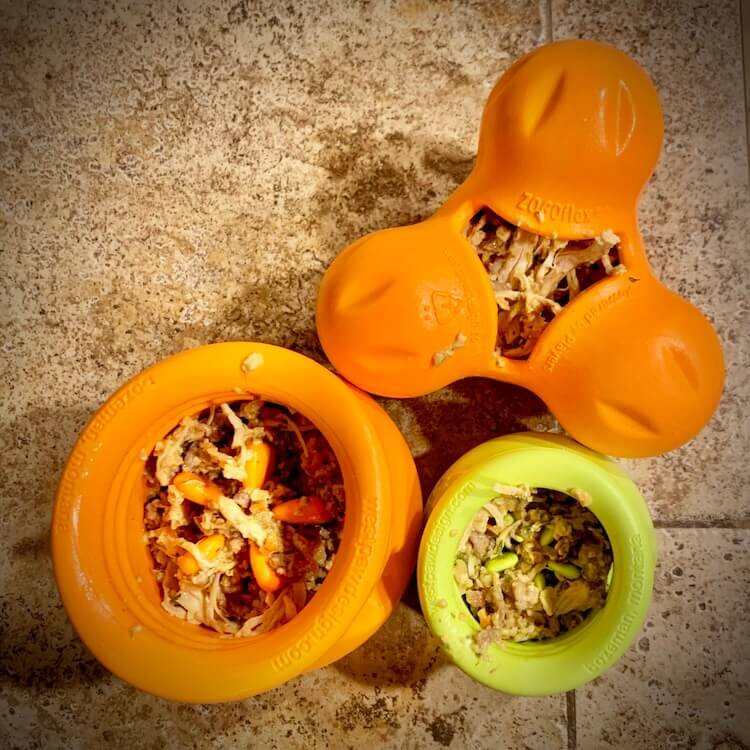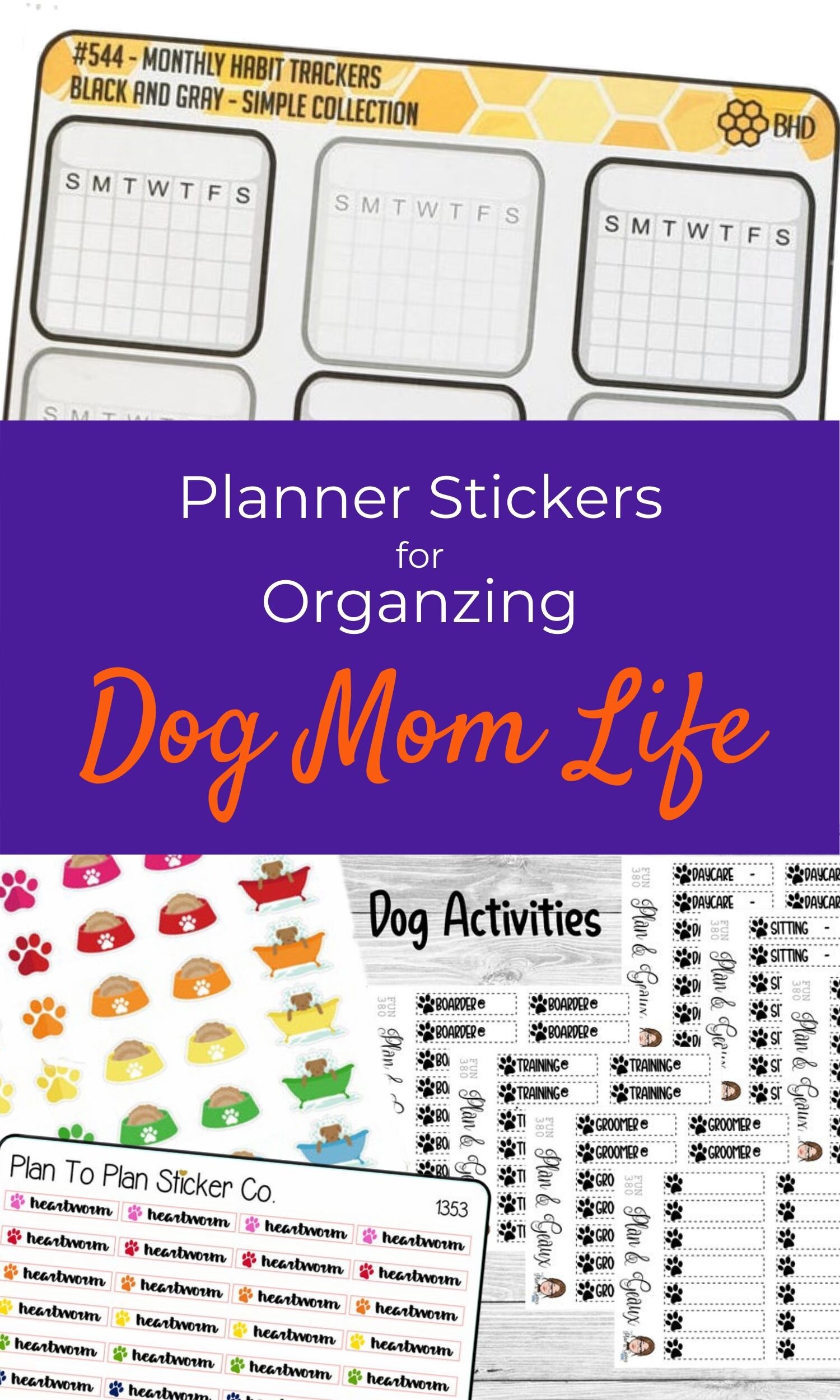Easy Canine Conditioning and Fitness
/April is Canine Fitness Month and Active Dog Month! Spring weather creates the perfect excuse to get outdoors with your dog. Walks, hikes, and swims are all part of our exercise routine.
Whenever we’re on a walk, I’m thinking about canine conditioning. I love finding objects that my dogs can interact with to build their flexibility, balance, and strength.
But when the weather doesn’t want to cooperate, keeping pets moving at home is important too.
This post may contain affiliate links, which means at no additional cost to you, I may earn a small commission if you click through and purchase something. Please see my Affiliate Link Disclosure policy for more details.
Benefits of Canine Fitness
Maintaining a healthy weight may increase your dog’s lifespan.
Keeping your dog fit is one strategy you can employ to help your dog live longer. Cummings Veterinary Medical Center at Tufts University published this short research review that highlights how keeping your dog at a healthy weight is good for your dog.
According to the Association for Pet Obesity Prevention, in 2018, they estimated that 56% of dogs in the United States were classified as either overweight or obese. Keep your dog in good physical shape to help him live longer.
Dog conditioning exercises may improve coordination and self-confidence.
People are sometimes surprised that dog’s do not have a natural awareness of their rear-end. When you see a dog awkwardly mis-stepping or tripping over his own hindquarters, that’s a dog with little rear-end awareness.
When you integrate more dog fitness exercises into a daily or weekly routine, you’re helping your dog improve his balance and coordination, which can also boost his confidence.
A dog fitness program or routine may reduce undesirable behaviors.
Let’s face it, just like humans, dogs can lead pretty sedentary lives. Dogs who don’t get enough physical exercise and mental enrichment get restless and bored. Bored dogs can get into trouble with destructive behaviors.
By incorporating different canine conditioning exercises, you’re keeping your dog moving physically while also engaging his brain. He’s figuring out what he’s supposed to be doing as you guide him through dog fitness exercises.
All of this exertion burns energy.
Exercise toys for dogs are great for rainy or snowy days.
Mother nature doesn’t always produce ideal weather for taking our dogs outside. When there’s rain, snow, or other inclement weather conditions, you need options to keep your dog active indoors.
Adding variety to your dog activities creates fun!
Who wants to do the same activities over and over with nothing ever changing?
When you create canine fitness stations or an engaging obstacle course of exercises, you’re keeping activities with your dog fresh.
Easy Dog Conditioning Exercises to Get Started
I’m listing exercises below that are easy for both the handler and most dogs. These exercises also use items you probably already have around the house as your dog exercise equipment.
What you’ll need:
a small box or block
a wall that your dog can put his front paws on
a way to create a jump - think broomstick between pieces of furniture or a hoola hoop
a tug toy
Please note: Not all exercises are appropriate for all dogs. Be sure to consult with your veterinarian or a canine conditioning fitness coach before you design an exercise routine for your dog. Puppies, senior dogs, and specific breeds have special needs that must be considered before starting certain activities.
Warming up - Just like humans, dogs need to warm up a little before they start exercising. If you’ve just come home from a walk, that’s an ideal time to ask your dog to do a few more exercises.
If your dog has been sleeping or relaxing, you can get him moving with a little activity, and some basic cues and tricks.
Even indoors, snap on his leash and walk him around your home for 2-3 minutes. Depending on your floor plan, this warm up exercise could also be great for practicing turns while loose-leash walking.
For puppy push ups, ask you dog to sit and then to stand. You can alternate with down as well for variety. Repeat a few times. Remember to treat your dog with something yummy.
If you’ve taught your dog some tricks, utilize them. Bow, circle or spinning in each direction, and backing up stretch and warm up many muscles.
Paws up on an object - This exercise is great because it requires your dog to balance his body weight in a fixed position. Be sure to practice this exercise on non-slippery flooring.
You can vary the height of the objects to make this exercise more or less challenging.
As your dog gets better with paws up, you can also vary the surface his hind legs are balancing upon. To begin you might change the texture of the surface below his paws. If you’ve been practicing on carpet, try going outside into the grass.
In Arizona, we have a lot of sand and dirt, so we practice on those cushiony surfaces.
Perchwork - This exercise takes paws up on an object a step further to work on your dog’s proprioception, which is basically his awareness of his own rear end to help him balance.
In the video below, Susan Garrett walks you through all the steps you need to teach your dog both paws up on an object and perchwork, which she refers to as pivots and spins. The video is a little longer (18 minutes), but it’s chock full of great training information.
Paws on a wall also known as a wall stand - If you want to work on your dog’s core strength, this exercise requires your dog to lift his entire front end up on the wall.
Just like paws on an object, be sure to have your dog standing on a non-slippery surface.
The tutorial video below is less than one minute long.
Jumping over a bar or a hoop jump - This exercise also works on your dog’s strength with a focus on bolstering the hind end.
For this exercise, you do need a non-slippery and cushioned surface to help prevent injury. Plush area rugs or carpets work well to reduce stress on joints and muscles.
The short tutorials below explain how to teach your dog to jump over a bar or through a hoop.
Play tug-of-war - Tug is another fun way to help your dog build strength while building a stronger human-animal bond with you.
Just remember to always manipulate the tug toy back and forth rather than up and down. Tugging up and down can hurt your dog’s neck.
The first video below features Victoria Stilwell walking you through how to safely play tug-of-war with your dog.
In the second video, Ken Steepe includes great tips on how to engage dogs who are more reluctant at playing tug.
Resources for Developing your Dog Fitness Plan
Start with your local resources.
We’re incredibly fortunate in Tucson to have A Loyal Companion: Canine Mobility & Swim Center. When Lizzie was a puppy, she and I took their Super Puppy Class where I began learning more about canine fitness in their indoor gym.
Now I handle most of their canine conditioning exercises either on walks or at home, but Bernie and Lizzie swim at A Loyal Companion every week.
Find out if there’s an indoor recreational gym for dogs in your area. Local dog trainers, groomers, and pet sitters should know what’s close by.
You can also find a Canine Conditioning Fitness Coach (CCFC) through Do More With Your Dog’s Find an Instructor web page.
If you can take a canine conditioning class at a local facility, you’ll learn proper techniques and see which pieces of canine fitness equipment work for you and your dog.
If there are no Canine Conditioning Fitness Coaches near you, you can join one of Do More With Your Dog’s free Spark Team Facebook groups.
Read Kyra Sundance’s book Canine Conditioning.
This well-organized book breaks canine fitness into five areas: flexibility, balance, stamina, coordination, and strength.
There are four levels of fitness within each area.
Colorful photos and graphics show clear step-by-step instructions. Many of the exercises integrate trick training, which helps keep dog fitness fun for you and your dog.
While some people have complained that too many of the canine conditioning exercises require expensive equipment, that’s just not the case. I went through the book and classified the 58 exercises:
8 exercises require no equipment.
26 exercises you can substitute the fancy equipment in the pictures with furniture, items you already have around your house, or easy DIY options.
18 exercises require buying some equipment, but if you replace the dog fitness equipment with human equipment, you’ll save money.
6 exercises require expensive equipment or items that would be inconvenient to store, like a treadmill, swimming pool or large barrel.
Follow Certified Professional Canine Fitness Trainer (CPCFT) Lisa Petterson.
Lisa offers several online classes and monthly personalized fitness coaching on her website.
Even better she offers a free Level 1 Fitness Circuit Plan that helps you better understand what a canine fitness circuit is, how many repetitions and sets you should be using, and how to identify the signs of fatigue.
She has also posted numerous videos on her Facebook page and YouTube channel that demonstrate various circuits, including circuits using DIY equipment. I like her videos because they’re easy for me to follow along.
Affordable Canine Fitness Equipment
If you’re seriously considering adding more canine conditioning activities to your daily or weekly repertoire, then you’re going to need equipment. That’s where some people stop short because canine fitness equipment can be pricey!
Don’t let the prices scare you away from dog conditioning exercises. There are many creative free options, including some simple DIY solutions, along with affordable alternatives to the name brands.
For exercises practicing paws on objects:
Stairs make a great place to hone paws up.
Stepping stools, including those for children, work well especially if the surface is textured.
Cardboard boxes weighted with books are pretty versatile.
If your dog is larger, plastic tubs or bins would work nicely. If you need a little more texture for the surface, try a door mat.
Shop at second-hand stores for used exercise equipment like yoga blocks.
Purchase a rubber feed pan. Be sure to read the dimensions carefully so you purchase a size that’s appropriate for your dog.
For practice with balancing:
Use sofa or chair cushions or throw pillows you have around the house.
Check second-hand stores for gently used balance balls, discs, and other yoga equipment at reasonable prices.
Purchase inflatable wobble cushions, peanuts, and balance pods from brands who cater to humans instead of canines. The human exercise equipment usually costs less.
Instead of paying top dollar for a wobble board, make one yourself. The tutorial video below shows you how to make a DIY wobble board for a fraction of the retail price.
For jumps or crawling under:
You could use a mop or broomstick through chair rungs.
If you have plastic milk crates, thread a mop/broom through the crisscross openings.
Cut a hole on one side of two different weighted cardboard boxes and thread a pool noodle through each box opening.
Purchase a hoola hoop from a dollar store or a craft store.
If you want an agility jump, you can make them out of PVC pipe. Check YouTube for tutorials.
For cardio dog fitness fun at home:
If you’ve never used a flirt pole with your dog, it’s an inexpensive game changer for cardio work outs and teaching impulse control.
We use the Outward Hound flirt pole because the non-bungee cord is a flexible nylon that won’t pop me or my dogs in the face.
The video below has the best instructions for how to play with a flirt pole safely.
For building an obstacle course:
Cones make great props for introducing your dog to weaving or barrel racing.
I use them with nose work or scent games with my dogs too.
You can purchase full-size cones at hardware stores. If you have smaller to medium-sized dogs, children’s cones may work for you. I like that they take up less space in my closet.
Agility tunnels can be expensive. This Houseables Dog Tunnel for small to medium-sized dogs is reasonably priced on Amazon for a tunnel we use a few times a month.
Letting your dog zip back and forth in a tunnel is a great way for them to burn off energy.
After two years of play, the only rip has been in the carrying case. The tunnel is still intact.
An agility ladder helps dogs space their steps more intentionally.
Many people make their own agility training ladder for their dog out of PVC pipe.
I’m not handy enough to cut PVC pipe, so I like the cost and ease of construction for the DIY pool noodle ladder featured in the video below.
If you’re a bit more serious about trying out agility objects:
I recommend the starter kit from Better Sporting Dogs, which comes with a 10’ long tunnel, a bar jump, a tire jump, weave poles, and a pause box.
We’ve had our starter kit for a few weeks now and our dogs love using it. I may be keeping the weave poles in a hallway for more regular practice.
I spent about 15 minutes putting the various agility objects together.
All of the pieces disassemble and fit nicely into four carrying cases that are easy to store.
Finally, the tunnel does come with sandbags, which have been heavenly. Stakes never work for me in our back yard, so I just throw a few stones into the sandbags and the tunnel stays put.




























































